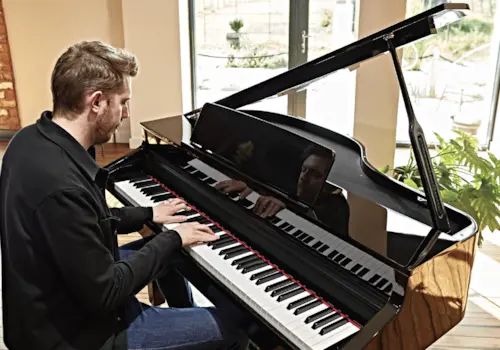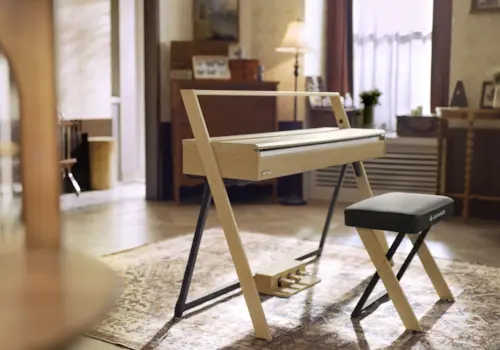For Alisdair Hogarth, the overuse of phrases such as ‘keep a loose wrist’ and ‘pass the thumb under’ will sometimes make him scratch his head. He explains why
In the first chapter of Charles Rosen’s fantastic book, Piano Notes, he talks about the conventionally accepted way of playing scales by crossing the thumb under the hand. He quotes Dinu Lipatti:
‘You know, it has been at least ten years since I last crossed my thumb under the third finger.’ Instead of crossing the thumb under the hand, Rosen himself goes on to say that: ‘It is better for me to keep my hand at a steady angle and displace the arm quickly to the right when shifting from the third finger to the thumb, and I have learned how to accomplish this legato’.
I was delighted when I read this, since this technique of shifting to the left or the right in a quick lateral movement is one of the first things Philip Fowke suggested to me when I began studying with him. I’ve used it ever since.
There are certain myths and regularly churned-out phrases in the piano world: ‘the passing under of the thumb’, ‘loose wrist’, ‘legato fingering’. Although a huge number of these ideas and concepts are extremely valuable, they can also often lead to a very one-sided approach to practice and to piano playing. I am always suspicious of methods and fixed ways of approaching piano technique, so in an attempt to balance things out, I’d like to offer five alternative viewpoints to common-held beliefs about piano playing and technique.
1 Scale fingering
The standard scale fingering that is taught to beginners in the early stages of learning the piano can certainly be very effective, and especially when the hands are playing separately. But when the hands are working together and playing in similar motion, the point at which the right hand and left hand have to manoeuvre the thumb or fingers to the next position happens at different moments. The thumb can act as an incredible anchor for the entire hand because of its position and its strength, and I realised that if you simply reverse the scale groupings in one hand (in other words in C major, start with 1234 followed by 123 and so on) the thumbs always happen at the same time, and the fingers playing the notes in between are also performing matching finger groups. This provides amazing security at high speed since there are regular strong checkpoints aligned with the thumbs in both hands. I’m not saying don’t use traditional fingering, but more that it is good to know there is more than one option to have in your technical toolbox.
2 Legato fingering
The phrase ‘legato fingering’ is something that I dread to hear. The general idea being that you find a fingering that creates perfect legato, often involving awkward contortions and twists, copious finger substitutions, general sweating, and then if necessary add a bit of pedal like a dollop of salsa just to spice things up a bit. This is something that has always puzzled me. Whilst it is vital to be able to produce a perfect legato, I would way rather opt for physical comfort and select a fingering that keeps my hand in a neutral and comfortable position and simply using the pedal to create the legato. Careful pedalling can also assist with other techniques I have mentioned in this article, most specifically with regard to lateral shifts when playing scales and arpeggios.
3 Passing under of the thumb
As mentioned at the beginning of this article, this is one of my biggest pet peeves, and I’m sure my piano colleagues get tired of hearing me rant about it. There is also a physical reason not to pass the thumb under the hand. That kind of twisting movement can place intense pressure on the thumb and the tendons around it – a movement that can potentially lead to hand injuries. Keeping the hand and wrist in a neutral position as much as possible is one of the fundamental ways to help avoid injury in piano playing. Another problem with passing the thumb under the fingers in scales and arpeggios is that as soon as the thumb arrives on its destination note, the other fingers are then as far away as they can be from the notes that they need to be playing next. When you shift the entire hand in one smooth lateral motion, the shift may feel quick at first but once the thumb has arrived, the other fingers will also be in position and ready for action.
4 Complete relaxation: don't tense up
Complete relaxation in piano playing is something that is regularly talked about in piano world, and of course it is important to play with as much comfort as possible. However, complete relaxation is not physically possible at all times when playing, since certain techniques and pieces are going to require muscular development and stamina. I prefer to think of relaxation as ‘firm flexibility’, remembering that a strong flexible muscle resists strain better than a strong inflexible one. If you are learning a piece like the piano part of Schubert’s pianistically feared Erlkönig the simple truth is that it will require dedicated stamina work and piano-strength training. I have played this piece many times in concert and I have found that even though I can achieve comfort in performance throughout, I wouldn’t say I am totally relaxed physically throughout the piece. I think a more useful way of thinking about relaxation is that it is more about knowing when to use strength and force and then when to balance this with relaxation. Either one of these two factors used in excess will produce less than good results. Too much strength could result in strain, but too much relaxation could result in a wobbly and weak sound.
5 Slow practice
This is a controversial one. I have found that slow practice, although useful, does not always yield the best results. This is highlighted brilliantly by the wonderful Mark Tanner in his detailed article in this issue on page 14. The problem with practising something slowly that ultimately is going to end up quick, is that it can all too often sound like speeded-up slow practice when you bring it up to tempo. This is because at a quick tempo you can’t provide the same intensity of weight on every single note as you can when playing slowly. I often find the best solution to playing quickly whilst retaining control, is to locate anchor points in each bar that I might practice as accents very strongly, then playing the notes in between much lighter. I have discovered that the more I do this and let my fingers off the hook a bit, whilst retaining focused anchor points at regular intervals, it is possible to retain relaxed control, without every single note sounding too strong. Essentially, the faster you play, the slower you think. Another approach is to take small units of the music, for example a bar or a half bar, and to practise it at tempo or above tempo several times. Then move to the next half bar or bar and do the same thing, and then when you feel confident, attach the two together at the correct tempo.
So why not be daring in your practice? Don’t believe what you hear. Challenge the norm, and get those inherently rebellious fingers working in a different way. You might be surprised at the results.
Need some further piano-learning inspiration? Download our FREE 'MASTERCLASSES' EBOOK which covers all types of topics from fingering to scales and arpeggio.
And...
Looking to improve your piano-playing skills this summer - or actually any time of the year? Why not sign up for a piano course?
Read the article on residential courses inside the current issue of Pianist.







